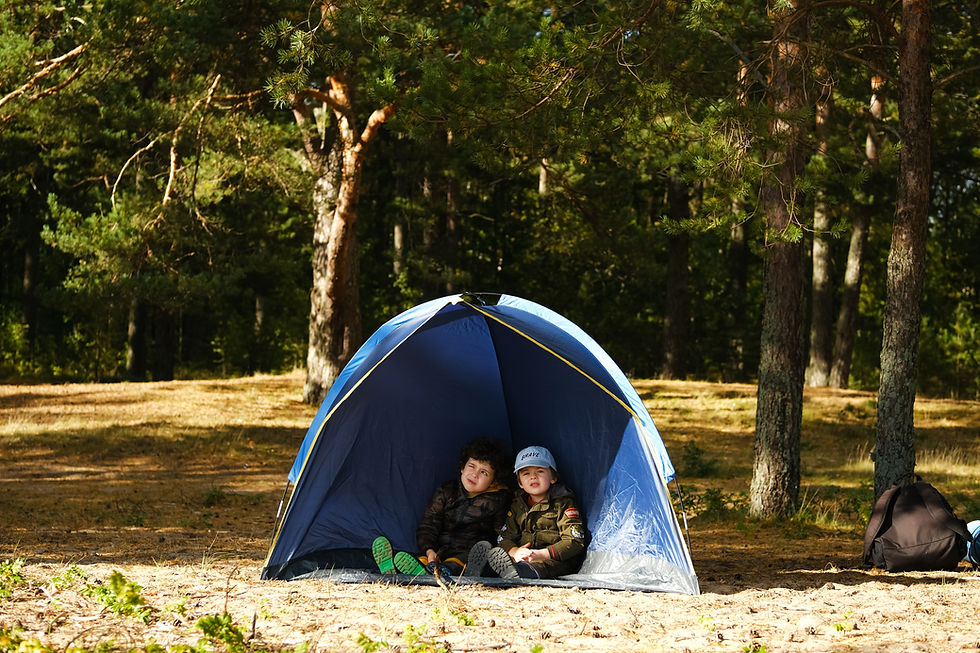Family Camping with a Tent: What to Know and Best Practices for Camping with Kids
- Q25.co.uk
- Aug 17, 2024
- 4 min read
Family camping is one of the most enriching experiences you can share with your children. It’s a time to unplug, connect with nature, and enjoy quality time together. Camping in a tent adds an element of adventure that kids often find exciting. However, to ensure your trip is both fun and stress-free, it’s essential to plan carefully. This blog will guide you through what you need to know and offer best practices for camping with kids.

Why Choose Tent Camping?
Camping in a tent offers a unique opportunity to immerse yourself in nature. Unlike staying in a cabin or RV, tent camping allows you to experience the sights and sounds of the outdoors fully. For kids, it’s an adventure they won’t forget—sleeping under the stars, hearing the rustle of leaves, and waking up to the sound of birds.
What to Know Before You Go
1. Choose the Right Tent
Selecting the right tent is crucial, especially when camping with kids. Consider the following when choosing your tent:
Size: Ensure the tent is spacious enough to accommodate your family comfortably. A good rule of thumb is to choose a tent that is rated for at least one or two more people than are in your group.
Ease of Setup: Look for a tent that is easy to set up and take down. Practice setting it up at home before your trip to avoid frustration at the campsite.
Weather Protection: Make sure the tent is suitable for the weather conditions you’ll be facing. Look for a tent with a good rainfly and a waterproof bottom.
2. Location is Key
The location of your campsite can make or break your camping experience. Here’s what to consider:
Proximity to Amenities: If you’re camping with young children, choose a campsite close to restrooms, water sources, and other amenities.
Safety: Ensure the site is safe for kids. Avoid areas with steep drop-offs, fast-flowing water, or dense wildlife.
Comfort: A flat, shaded area is ideal for setting up your tent. It provides comfort and protection from the elements.
3. Packing Essentials
Packing for a family camping trip requires careful consideration. Here are the essentials:
Sleeping Gear: Pack comfortable sleeping bags, sleeping pads, or air mattresses. Don’t forget pillows and blankets for extra warmth.
Clothing: Bring layers to accommodate varying temperatures. Include rain gear and extra clothes in case the kids get wet or dirty.
Cooking Supplies: A portable stove, pots and pans, utensils, and plenty of food are must-haves. Don’t forget marshmallows for roasting over the campfire!
First Aid Kit: Accidents can happen, so it’s important to have a well-stocked first aid kit on hand.
Entertainment: Bring along games, books, or outdoor toys to keep the kids entertained. Nature scavenger hunts or storytelling around the campfire are great activities.
Best Practices for Camping with Kids
1. Involve Kids in the Planning
Get your kids excited about the trip by involving them in the planning process. Let them help choose the campsite, plan meals, and pack their own gear. This not only builds excitement but also teaches responsibility.
2. Establish a Camp Routine
Kids thrive on routine, even when camping. Set up a daily schedule that includes mealtimes, activities, and bedtime. A consistent routine helps keep kids calm and reduces the chances of meltdowns.
3. Safety First
Camping is fun, but it’s important to stay safe:
Teach Basic Safety Rules: Explain the dangers of wandering off, interacting with wildlife, and handling campfires. Set clear boundaries around the campsite.
Supervision: Always keep an eye on your kids, especially near water or when a campfire is burning.
4. Make It Fun and Educational
Camping is a great opportunity for learning:
Nature Exploration: Encourage your kids to explore the natural surroundings. Teach them about the plants, animals, and stars they see.
Camping Skills: Teach them basic camping skills, like how to set up a tent, start a fire, or read a map. These skills are not only useful but also boost their confidence.
5. Be Flexible and Patient
Camping with kids can be unpredictable, so it’s important to remain flexible. Plans may change due to weather, mood swings, or unexpected challenges. Stay patient and go with the flow to keep the experience enjoyable for everyone.
6. Leave No Trace
Teach your kids the importance of respecting nature by following the Leave No Trace principles. Pack out all trash, respect wildlife, and leave the campsite as you found it.
Conclusion
Family camping in a tent is a rewarding experience that creates lasting memories. By choosing the right gear, planning ahead, and following best practices, you can ensure a fun and safe adventure for the whole family. So, pack up the tent, gather your loved ones, and head out into the great outdoors for an unforgettable family camping trip!
If you found these tips helpful, please share this blog with other families. We’d love to hear about your camping experiences and any additional tips you have in the comments below!




Comments